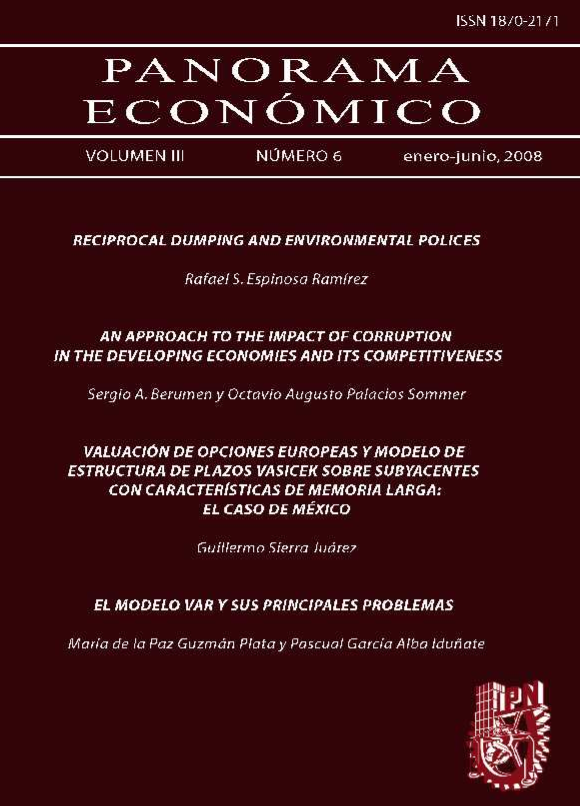Reciprocal Dumping and Environmental Polices
Contenido principal del artículo
En un modelo de comercio con dumping recíproco se analizan los efectos sobre el bienestar de una reforma de política ambiental, en un contexto de desempleo y repatriación de beneficios. Las cuotas de contaminación, determinadas por el gobierno de cada país, restringen la producción local y reducen el daño social de la contaminación. Sin embargo, la cuota es una barrera comercial que inhibe el empleo y reduce el excedente de los consumidores. Teniendo presente tales aspectos, los países acuerdan una disminución uniforme de la cuota de contaminación, de manera infinitesimal y proporcionada. En ambos casos, el bienestar global se incrementará si la desutilidad marginal de la contaminación es mayor que el costo de reducirla. El efecto en cada país dependerá del tamaño del mercado y de los costos tecnológicos marginales. Bajo las mismas condiciones, cuando los países acuerdan armonizar sus cuotas de contaminación, el bienestar global se incrementará, pero el efecto sobre el bienestar de cada país será diferente.
Asako, K. (1979), “Environmental pollution in an open economy”, Economic Record 55(151), 359-367.
Balassa, B. (1966), “Tariff reductions and trade in manufactures”, American Economic Review 56, 466-473.
Barret, S. (1994), “Strategic environmental policy and international trade”, Journal of Public Economics 54, 325-338.
Baumol, W.J. and W.E. Oates (1988), The Theory of Environmental Policy, Cambridge, Cambridge University Press.
Bhagwati, J. (1995), Free trade, ‘fairness’ and the new protectionism: reflections on an agenda for the World Trade Organisation, Wincott memorial lecture, 24th Occasional paper, Institute of Economic Affairs, 96, London: Institute of Economic Affairs for the Wincott Foundation.
Brander, J. (1981), “Intra industry trade in identical commodities”, Journal of International Economics 11, 1-14.
Brander, J.A. and P. Krugman. (1983), “A ‘reciprocal dumping’ model of international trade”, Journal of International Economics 15, 313-321.
Brander, J.A. and B.J. Spencer (1985), “Export subsidies and international market share rivalry”, Journal of International Economics 18, 83-100.
Brander, J.A. and B.J. Spencer (1987), “Foreign direct investment with unemployment and endogenous taxes and tariffs”, Journal of International Economics 22, 257-279.
Bulow, J.I., J.D. Geanakoplos and P. Klemperer (1985), “Multimarket oligopoly: strategic substitutes and complements”, Journal of Political Economy 93, 488-511.
Caves, R. (1982), Multinational enterprise and economic analysis, Cambridge Surveys of Economics, Cambridge University Press.
Caves, R. and R.W. Jones (1977), World trade and payments, 2nd edn. Little, Brown and Company, Boston.
Copeland, B.R. (1996), “Pollution content tariffs, environmental rent shifting, and the control of cross border pollution”, Journal of International Economics 40, 459-476.
Copeland, B.R. and M.S. Taylor (1995), “Trade and transboundary pollution”, American Economic Review 85, 716-737.
Copper, M.L. and W.E. Oates (1992), “Environmental economics: A survey”, Journal of Economic Literature 30, 675-740.
Dixit, A.K. (1986), “Comparative statics for oligopoly”, International Economic Review 27, 107-122.
Kanbur, R., M. Keen and S. Van Wijnbergen (1995), “Industrial competitiveness, environmental regulation and direct foreign investment”, in: Golding, I. and L.A. Winters (eds.), The economics of sustainable development (Cambridge University Press).
Keen, M. (1987), “Welfare effects of commodity tax harmonisation”, Journal of Public Economics 33, 107-114.
Keen, M. (1989), “Pareto improving indirect tax harmonisation”, European Economic Review 33, 1-12.
Keen, M. and R. Kanbur (1993), “Jeux sans frontières: tax competition and tax coordination when countries differ in size”, American Economic Review 83, 877-892.
Keen, M. and S. Lahiri (1993), “Domestic tax reform and international oligopoly”, Journal of Public Economics 51, 5574.
Krugman, P. (1979), “Increasing returns, monopolistic competition and international trade”, Journal of International Economics 9, 469-479.
Lahiri, S. and Y. Ono (1998a), “Protecting environment in the presence of foreign direct investment: tax versus quantity restriction”, mimeo Department of Economics, University of Essex.
Lahiri, S. and Y. Ono (1998b), “Tax competition in the presence of cross hauling”, Weltwirtschaftliches Archiv 134, 263-279.
Lancaster, K. (1980), “Intra industry trade under perfect monopolistic competition”, Journal of International Economics 10, 151-175.
Low, P. and A. Yeats (1992), “Do dirty industries migrate?” in P. Low, (ed.), International Trade and the Environment, The World Bank, Washington DC, 89-103.
Lucas, R.E.B., D. Wheeler and H. Hettige (1992), “Economic development, environmental regulation and the international migration of toxic industrial pollution: 1060-1988” in P. Low, (ed.), International Trade and the Environment, The World Bank, Washington DC, 89-103.
Markusen, J.R., E.R. Morey and N. Olewiler (1993), “Environmental policy when market structure and plant locations are endogenous”, Journal of Environmental Economics and Management 24, 69-86.
Markusen, J.R., E.R. Morey and N. Olewiler (1995), “Competition in regional environmental policies when plant locations are endogenous”, Journal of Public Economics 56, 55-57.
Merrifield, J.D. (1988), “The impact of selected abatement strategies on transnational pollution, the terms of trade, and factor rewards: a general equilibrium approach”, Journal of Environmental Economics and Management 15, 259-284.
Nikaido, H. (1968), Convex structures and economic theory, Academic Press, New York.
Pethig, R. (1979), “Environmental management in general equilibrium: a new incentive compatible approach”, International Economic Review 20, 1-27.
Seade, J. (1980), “On the effects of entry”, Econometrica 48, 479-489.
UNCTAD (1998), World investment report 1998: Trends and Determinants, United Nations Publications.
Detalles del artículo

Esta obra está bajo una licencia internacional Creative Commons Atribución-NoComercial-SinDerivadas 4.0.







